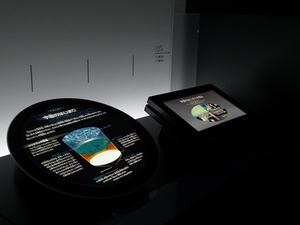Nagoya City Science Museum
TOP > Exhibition Guide > Keyword Search > Starting with "U" > universe > The Edge of the Universe
The Edge of the Universe



Purpose of Exhibition
Come into this gallery from the north entrance and walk clockwise around the perimeter, looking at the displays, you will travel from our earth to the end of the Universe. The outer ring is lined with various astronomical objects and cosmic events in order. This exhibit is based on the idea of Powers of Ten, where the scale increases tenfold each time.
You have finally reached the edge of the Universe, through the earth, solar system, the world of stars, our galaxy and other galaxies. This exhibit will show you the large-scale structure of the Universe and the history of the Universe from the Big Bang to the present on a large screen, as well as the Expanding Universe, mapping the Universe and the dawn of the Universe.
Additional Knowledge
[What Is the Edge of the Universe?]
If you travel straight all the way through the Universe, do you think you would get to an edge of the Universe, like the wall in the ancient view of the world? It is a very curious question.
Before considering about the boundary of the Universe, let’s think about the surface of the earth. If you go straight ahead interminably, you will eventually come back to the place where you were originally, for the earth is round. In short, there is no end or edge of our earth. If the Universe is spatially curved like the earth, we can say the Universe has no edge. In such universe, if you observe far enough, you would be able to see your own back someday.
In the 21st century, however, we now know that the Universe is flat, not spatially curved, from precise observations of the temperature fluctuations of cosmic microwave background (CMB), the oldest light from an early stage which fills the entire Universe. Thus, the world is like being on a flat plane. If you were to observe far enough, one day you would see the edge of the Universe.
Now, let’s consider that our universe has not only a three-dimensional spatial extent, but also a dimension of time. Since the speed of light is finite, when you observe a distance, you are looking into the past just as old as it takes time for light to reach your place; light from one year away takes one year to reach you, so looking one light year away means that you are looking into the past one year. If it is 100 million light years away, the Universe you are looking is 100 million years old.
Our universe, as you know, began with the Big Bang 13.8 billion years ago, and there was nothing before that. If you were to look farther and farther with a giant telescope, you would one day reach 13.8 billion light years. If you might try to observe beyond this point, it means that you attempt to look into a time before the world began, as the Universe is 13.8 billion years old. In short, the edge of the observable universe is theoretically 13.8 billion light years away from you.
This page was last edited on 30 June 2022.
Article by Astronomy Section
